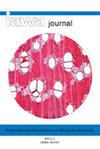Structure of the secondary xylem and development of a cambial variant in Serjania mexicana (Sapindaceae)
IF 1.4
3区 农林科学
Q2 FORESTRY
引用次数: 1
Abstract
The lianas in the family Sapindaceae are known for their unique secondary growth which differs from climbing species in other plant families in terms of their cambial variants. The present study deals with the stem anatomy of self-supporting and lianescent habit, development of phloem wedges, the ontogeny of cambial variants and structure of the secondary xylem in the stems of Serjania mexicana (L.) Willd. Thick stems (15–20 mm) were characterized by the presence of distinct phloem wedges and tangentially wide neo-formed cambial cylinders. As the stem diameter increases, there is a proportional increase in the number of phloem wedges and neo-formed vascular cylinders. The parenchymatous (pericyclic) cells external to phloem wedges that are located on the inner margin of the pericyclic fibres undergo dedifferentiation, become meristematic and form small segments of cambial cylinders. These cambia extend tangentially into wide and large segments of neoformations. Structurally, the secondary xylem and phloem of the neo-formed vascular cylinders remain similar to the derivatives produced by the regular vascular cambium. The secondary xylem is composed of vessels (wide and narrow), fibres, axial and ray parenchyma cells. The occurrence of perforated ray cells is a common feature in both regular and variant xylem.墨西哥Serjania mexicana(Sapindaceae)次生木质部的结构和形成层变体的发育
无患子科的藤本植物以其独特的次生生长而闻名,与其他植物科的攀缘植物在形成层变异方面有所不同。本研究对墨西哥Serjania mexicana(L.)Willd茎的自持和藤本习性的茎解剖、韧皮楔的发育、形成层变异的个体发生以及次生木质部的结构进行了研究。粗茎(15-20 mm)的特征是存在明显的韧皮部楔和切向宽的新形成的形成层圆柱体。随着茎直径的增加,韧皮部楔和新形成的维管柱的数量成比例增加。位于周环纤维内缘的韧皮楔外部的薄壁(周环)细胞经历去分化,成为分生组织,并形成形成圆柱体的小段。这些形成层切向延伸到新地层的宽而大的部分。在结构上,新形成的维管圆柱体的次生木质部和韧皮部与规则维管形成层产生的衍生物保持相似。次生木质部由导管(宽和窄)、纤维、轴向和射线薄壁组织细胞组成。穿孔射线细胞的出现是规则木质部和变异木质部的共同特征。
本文章由计算机程序翻译,如有差异,请以英文原文为准。
求助全文
约1分钟内获得全文
求助全文
来源期刊

IAWA Journal
农林科学-林学
CiteScore
3.40
自引率
15.80%
发文量
26
审稿时长
>36 weeks
期刊介绍:
The IAWA Journal is the only international periodical fully devoted to structure, function, identification and utilisation of wood and bark in trees, shrubs, lianas, palms, bamboo and herbs. Many papers are of a multidisciplinary nature, linking
 求助内容:
求助内容: 应助结果提醒方式:
应助结果提醒方式:


